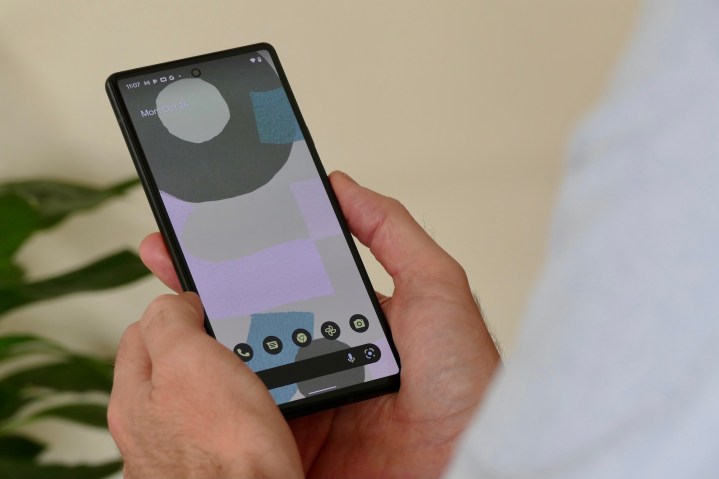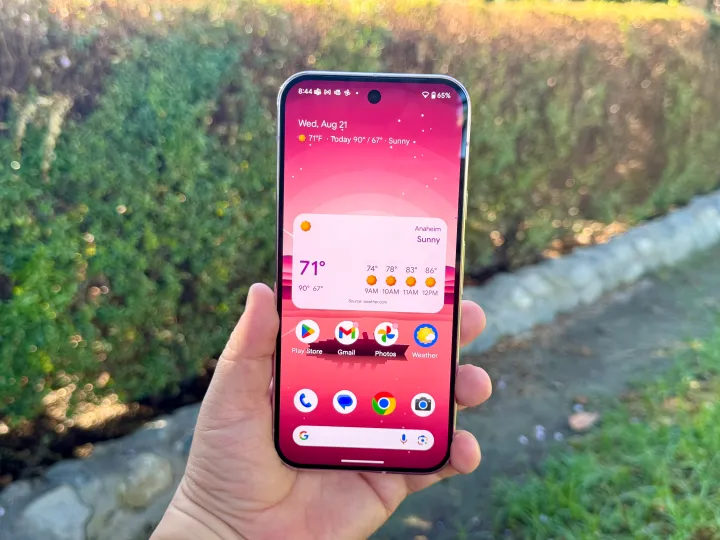The Google Pixel 9 has been released. The new phone targets entry-level smartphone buyers and was introduced alongside the Pixel 9 Pro, Pixel 9 Pro XL, and Pixel 9 Pro Fold. It comes with a host of impressive features. The Google Pixel 6 has been officially retired with the release of the Google Pixel 9 series. The phone launched in October 2021 alongside the Pixel 6 Pro.
If you own a 2021 Google Pixel 6, then you presumably chose not to upgrade to the Pixel 7 or Pixel 8. So, is it time to upgrade now? Let’s look at the main differences between the Pixel 9 and the Pixel 6.
Google Pixel 9 vs. Pixel 6: specs
| Google Pixel 9 | Google Pixel 6 | |
| Dimensions | 152.8 x 72.0 x 8.5 mm
6.0 x 2.8 x 0.3 inches |
158.6 x 74.8 x 8.9 mm
6.24 x 2.94 x 0.35 inches |
| Weight | 198 grams
7 ounces |
207 grams
7.30 ounces |
| Display | 6.3-inch Actua OLED display
1080 x 2424 resolution at 422 ppi 60-120Hz dynamic refresh rate 1800 nits (HDR)/2700 nits (peak) |
6.4-inch AMOLED display
1080 x 2400 resolution at 411 ppi 60-90Hz dynamic refresh rate 500 nits (HDR)/800 nits (peak) |
| Durability | IP68
Corning Gorilla Glass Victus 2 |
IP68
Corning Gorilla Glass Victus |
| Colors | Peony
Wintergreen Obsidian Porcelain |
Stormy Black
Sorta Seaform Kinda Coral |
| Processor | Google Tensor G4 | Google Tensor |
| RAM | 12GB | 8GB |
| Storage | 128GB
256GB |
128GB
256GB |
| Software | Android 14 | Android 12 |
| Updates | Seven years (through Android 21 or 22) | Three years (through Android 15) |
| Rear cameras | 50MP main camera, f/1.68 aperture and 82-degree FOV
48MP ultrawide lens, f/1.7 aperture and 123-degree FOV |
50MP main camera, f/1.9 aperture and 82-degree FOV
12MP ultrawide lens, f/2.2 aperture and 114-degree FOV |
| Front camera | 10.5MP with autofocus, f/2.2 aperture, and 95-degree ultrawide FOV | 8MP with fixed focus, f/2.0 aperture, and 84-degree ultrawide FOV |
| Battery | 4,700mAh | 4,614mAh |
| Charging | 27W wired fast charging
15W wireless (with Google Pixel Stand 2nd gen) or 12W with Qi-compatible wireless chargers Reverse wireless charging |
21W wired fast charging
21W wireless (with Google Pixel Stand 2nd gen) or 12W with Qi-compatible wireless chargers Reverse wireless charging |
| Price | Starts at $799 | When sold, started at $599 |
| Release date | August 2024 | October 2021; discontinued August 2024 |
| Review | Pixel 9 | Pixel 6 |
Google Pixel 9 vs. Pixel 6: design and display

The regular-sized Pixel 6 features a horizontal camera bar on the back, housing the camera lenses and flash. The back has the distinct two-tone design that was iconic for Pixels of the time, but hasn’t been used since. It was initially offered in three color options: Stormy Black, Kinda Coral, and Sorta Seafoam.
The older phone features a 6.4-inch AMOLED flat display with minimal bezels protected by Gorilla Glass Victus on both the front and back. It has an aluminum frame. The display offers 1080 by 2400 resolution at 411 pixels-per-inch, and its dynamic refresh rate maxes out at 90Hz. By today’s standards, the Pixel 6 display’s brightness levels are lacking, with only 500 nits (HDR) and a peak brightness of just 800.

As you might expect, the range’s design changed a lot between the Pixel 9 and the Pixel 6. The new model has a redesigned frame with flattened edges, replacing the curved design of previous models. While the corners are still rounded, the new design makes it easier to hold.
The camera bar design on the Pixel 9 is noticeably different from previous Pixels. It now features a more elongated capsule-shaped module that never reaches the phone’s sides. Despite this change, the Pixel 9 still only has a dual-camera system.
The newer phone’s display is slightly smaller at 6.3 inches compared to the 6.4 inches of the older model. However, it offers a higher-quality display with improved resolution, better refresh rates, and a peak brightness of 2,700 nits. The display is also protected by Corning Gorilla Glass Victus 2, which is more resistant to drops than the older version.
The Pixel 9 is available in four mostly reserved colors: Peony, Wintergreen, Obsidian, and Porcelain.
Google Pixel 9 vs. Pixel 6: cameras

The Google Pixel phones are recognized for their impressive camera systems, which Google continually enhances through software updates. There are noticeable hardware distinctions between the Pixel 9 and Pixel 6.
The Pixel 9 and Pixel 6 feature a dual-rear camera system with a 50MP primary camera. However, the Pixel 9 offers a slightly better aperture and a wider field of view for this lens. Additionally, the Pixel 9 has a 48MP ultrawide lens, while the Pixel 6 has a 12MP ultrawide lens. This is a noticeable difference and one of the reasons to consider upgrading to the Pixel 9.
For selfies, the Pixel 9 has a 10.5MP front camera with autofocus, while the Pixel 6’s selfie camera is 8MP with fixed focus. Once again, this is a big difference.
But specs only tell part of the story; how does it play out in real life? Well, while the Pixel 6 was lauded in its time for its image quality (and rightly so), it’s no surprise the Pixel 9 blows it out of the water. The newer phone is a significant jump up in image quality.
Google Pixel 9 vs. Pixel 6: performance

When the Pixel 6 series was released in 2021, it introduced the first-generation Google Tensor chip. Before this, Pixel phones had Qualcomm Snapdragon chips. The first Google Tensor introduced many features that Pixel users still love today, such as improved speech recognition, advanced camera features like Magic Erase, and enhanced language processing.
However, the first Tensor had its faults. It was criticized for its performance, falling short of the top-tier Qualcomm Snapdragon chips. Some also questioned its impact on modem performance and heat management.
There have been significant positive changes with the Pixel 9 and its Google Tensor G4 processor compared to the first-generation chip. This means notable performance improvements and better power efficiency. With the Tensor G4, the Pixel 9 offers 12GB of RAM, compared to the 8GB on the Pixel 6. Interestingly, Google still only offers 128GB or 256GB of storage on its entry-level Pixels.
Google Pixel 9 vs. Pixel 6: software and updates

The Pixel 6 was launched with Android 12 installed. Users were initially promised at least two years of operating system updates, guaranteeing an upgrade to Android 14. We now know, however, that Pixel 6 users will also be able to experience Android 15, which is set to be released soon.
On the other hand, Pixel 9 phones come with Android 14 and naturally support Android 15. Google commits to providing at least seven years of operating system updates for these phones. This means new Pixel 9 buyers could receive support for Android 22 before their phones become outdated, which is quite impressive.
While both Pixel 6 and Pixel 9 will support Android 15, only the newer model fully supports all of Google Gemini. While Google may eventually introduce some Google Gemini features to phones older than the Pixel 8 series, it’s becoming increasingly unlikely. This is because the AI tool has specific hardware requirements that older phones like the Pixel 6 don’t have.
Google Gemini, like Samsung’s AI and Apple Intelligence, will play a significant role in shaping the capabilities of AI in mobile devices in the coming years. If you’re not interested in artificial intelligence and own a Pixel 6, then this may not be relevant to you. However, if you are even a bit curious about AI, upgrading is crucial, and moving to the Pixel 9 is a great option.
Google Pixel 9 vs. Pixel 6: battery and charging

The Pixel 6 is equipped with a 4,614mAh battery, which provides a minimum of one day of moderate usage before requiring recharging. The Pixel 9 includes a slightly larger 4,700mAh battery. That might not sound like a big jump. However, thanks to the Tensor G4, this battery should give you at least one day of use, even with moderate to heavy usage.
Both phones support wired, wireless, and reverse charging. The Pixel 9 generally charges faster than the Pixel 6, but this depends on the right equipment.
The Pixel 6 supports wireless charging using the Qi standard and a 30-watt fast-wired charging option. The Pixel 9 supports 45-watt chargers but charges at a maximum of 27W and also offers Qi wireless charging.
Both phones can benefit from being charged with the Pixel Stand 2, which improves Pixel phone charging overall.
Google Pixel 9 vs. Pixel 6: verdict

It’s becoming more challenging to recommend that phone users upgrade their devices annually. While changes are made, they are typically not substantial from only one year to the next. However, this isn’t the case when comparing a phone released in 2021 to one released three years later.
For those who currently own a Pixel 6, there are several compelling reasons to consider upgrading. The Pixel 9 boasts a superior display, chip, and enhanced rear and front cameras. Additionally, it showcases a completely new design, ensuring your phone will stand out. Furthermore, only the Pixel 9 supports Google Gemini, where lots of software updates will be made for Pixel phones in the coming years.
Lastly, Android 15 will be the final version of Android that the Pixel 6 will support, in contrast to the Pixel 9, which promises seven years of software updates. This is a big difference and a good point to consider.
On the downside, you’ll pay more for the Pixel 9 than you did for the Pixel 6. You’ll also have to say goodbye to your phone’s striking two-tone design. But even with that in mind, for most folks, now’s the time to upgrade from the Pixel 6 to the Google Pixel 9.

